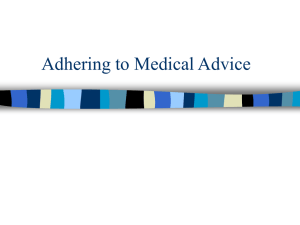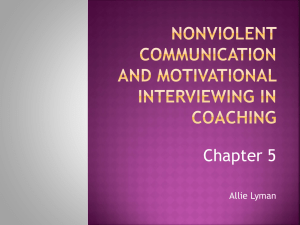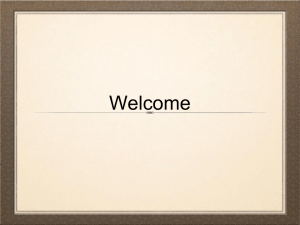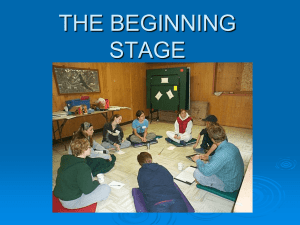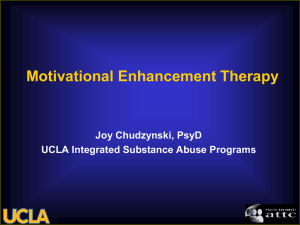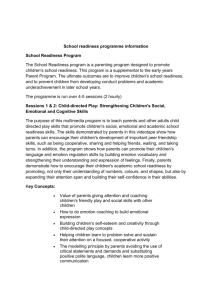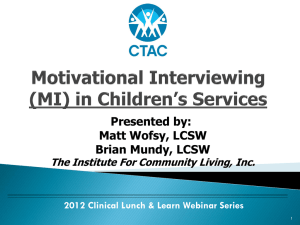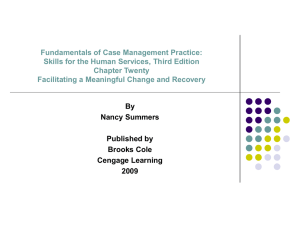Applying Motivational Interviewing to Geriatric Medicine
advertisement
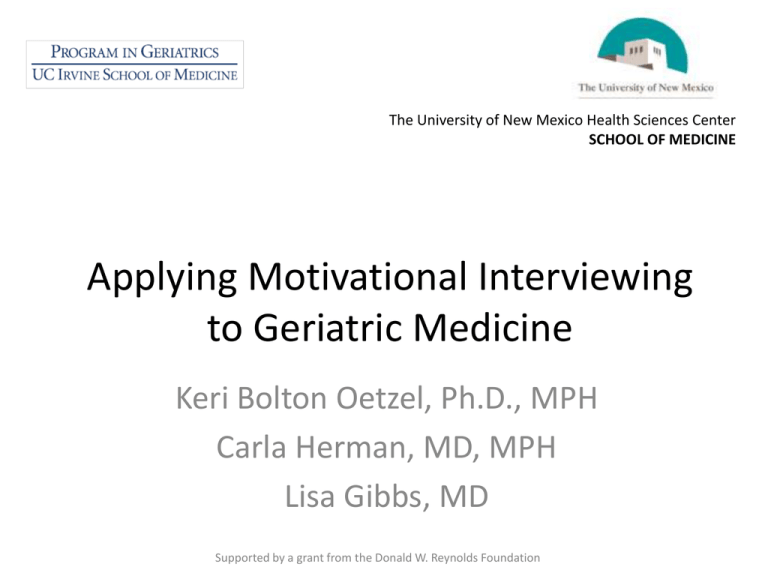
The University of New Mexico Health Sciences Center SCHOOL OF MEDICINE Applying Motivational Interviewing to Geriatric Medicine Keri Bolton Oetzel, Ph.D., MPH Carla Herman, MD, MPH Lisa Gibbs, MD Supported by a grant from the Donald W. Reynolds Foundation Objectives • Identify at least three approaches to effective communication • Assess a patient’s readiness to change • Determine how this assessment of readiness to change can be used clinically to develop constructive dialogue about behavior change • Identify case examples in the care of older adults and/or their caregivers suitable for MI techniques Definition of MI • “A person-centered, directive method of communication for enhancing intrinsic motivation to change by helping clients explore and resolve ambivalence.” Miller & Rollnick (2002) How is MI Different? Why Use MI? • 1st meeting matters! • MI + Active treatment • Bigger effect with minority samples than with Anglo/White samples • Broadly applicable • Increases treatment retention • Increases treatment adherence Studies of Interest • MI & Cardiac Care (Watkins et al, 2007) – n=411 – MI leads to improvement in patient mood 3 months post stroke • Adherence to Medication (Solomon et al, 2010) – n=879 – MI leads to improved medication adherence for people with osteoporosis Studies of Interest Continued • Anxiety & Older Adults (Stanley et al, 2009) – n=134 – CBT with MI resulted in greater improvement in worry severity, depressive symptoms, and general mental health MI in Geriatrics • • • • • • Using a walker Moving into assisted living Stopping driving Decreasing drinking Attending day care Talking with family members, inviting family members to engage in a different way • End-of-life discussions Spirit of MI • • • • • Develop Discrepancy Avoid Argumentation Roll with Resistance Express Empathy Support Self-efficacy Develop Discrepancy • Awareness of consequences is important • A discrepancy between present behavior and important goals will motivate change • The patient should present the arguments for change Avoid Argumentation • Arguments are counter productive • Defending breeds defensiveness • Resistance is a signal to change strategies Roll with Resistance • • • • Momentum can be used to good advantage Perceptions can be shifted New perspectives are invited but not imposed The patient is a valuable resource in finding solutions to problems Express Empathy • • • • Acceptance facilitates change Skillful reflective listening is fundamental Ambivalence is normal Respond to a patient’s ambivalence as understandable, comprehensible, and valid Support Self-efficacy • Belief in the possibility of change is an important motivator • The patient is responsible for choosing and carrying out personal change • There is hope in the range of alternative approaches available Helpful Skills • Using And vs But • Asking Permission • Assessing Readiness/Importance/Confidence And versus But But… • I want my dad to be healthy, but… • It might be a problem, but everyone in my family… • You’ve made a lot of changes, but… And… • I want my dad to be healthy and I don’t want to deprive him • It might be a problem and I am confused because everyone in my family has diabetes • You’ve made a lot of changes, and some things are more difficult than others Advice Giving & Asking Permission • MI adherent only if you have permission – Ask permission – They ask for it – Give permission to disregard it Assessing Readiness to Change • On a scale of 0-10, how ready are you to think about________? 0 1 2 3 4 5 6 7 8 9 10 • Backward question: Why a 5 and not a 3? • Straight question: Why a 5? • Forward question: What would it take for you to move from a 5 to 7? Future Directions • • • • • Inter-professional Model Teaching MI/Core Faculty Using MI in Teams Curriculum for MI in Geriatrics SIM Labs
